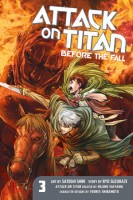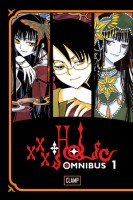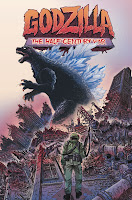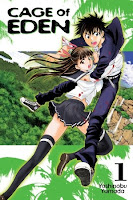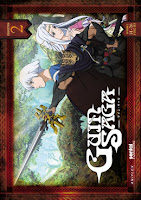My News and Reviews
An interesting variety of things was posted last week at Experiments in Manga. First of all, I had the privilege and opportunity to announce one of Sparkler Monthly‘s most recent additions, Kôsen’s Lêttera, a three-volume comic that was originally published in Spain. The winner of the Yukarism giveaway was announced last week as well. The post also includes a list of manga that feature reincarnation. As for reviews, I took a look at Akira Arai’s debut novel A Caring Man which shared the inaugural Golden Elephant Award grand prize with Fumi Nakamura’s Enma the Immortal. Whereas Enma the Immortal is historical fiction with fantastical elements, A Caring Man is a contemporary crime thriller that by and large is very believable. Finally, over the weekend I posted March’s Bookshelf Overload, which features a slightly less absurd amount of manga than most months.
Elsewhere online, Organization Anti-Social Geniuses has been posting some great manga-related content, including recording of a panel with manga editor and letterer Abigail Blackman from the Castle Point Anime Convention and a quick interview with editor Brendan Wright about Dark Horse’s upcoming release of Makoto Yukimura’s Planetes. (I’m very excited for this license rescue! I already own Tokyopop’s edition of the series, but Dark Horse’s sounds like it will be great, so I’ll most likely be double-dipping.) And speaking of Dark Horse, the final volume of Hiroaki Samura’s Blade of the Immortal was released last week. Robot 6 has an interview with Philip Simon reflecting on the manga’s end. Chic Pixel has a guide on how to import manga cheaply from Amazon Japan. Throughout March, the Comic Book Legal Defense Fund posted a series of articles, Women Who Changed Free Expression, the last of which focused on the influential 24 Nengumi, or the Year 24 Group, as the female progenitors of shoujo manga.
Anime Boston took place over the weekend. Both Yen Press and Kodansha Comics had some pretty exciting announcements to make. Yen Press has licensed thirteen new manga, some of which will be digital-only releases. The two print releases that particularly caught my attention were the omnibus edition of Yowamushi Pedal, particularly surprising since it’s a sports manga that’s nearly forty volumes lone and still ongoing in Japan, and the yonkoma Monthly Girls’ Nozaki-kun which, if it’s anywhere near as good as the anime adaptation, should be fantastic. As for Kodansha’s announcements, Attack on Titan, Volume 16 will have a special edition. New licenses include Ninja Slayer Kills, two video game-related manga—Persona Q and Devil Survivor—and Junji Ito’s Cat Diary, which is the one I’m personally most excited for. Also revealed was the status of Vinland Saga, which had temporarily been suspended. Basically, only two more volumes are guaranteed to be released unless sales for the series improve. Vinland Saga is magnificent; if you haven’t already given it a try, this would be the time to do it!
Quick Takes
 Barakamon, Volumes 2-3 by Satsuki Yoshino. While I largely enjoyed the first volume of Barakamon, I wasn’t particularly blown away by it. Still, I was interested in reading more of the series. I’m glad that I did, because it’s really starting to grow on me. Barakamon does have a little bit of a story to it—the once successful and respected calligrapher Seishuu has moved to a remote island to regain his composure and maybe find some inspiration—but mostly the series is about its characters and their interactions with one another. Even though he’s still a city-boy at heart, Seishuu has started to settle in on the island and isn’t nearly as out-of-place as he once was. The humor seems to now be a little less about the differences between country folk and people from more urban areas (although there still is plenty of that, especially when a couple of Seishuu’s friends and admirers from Tokyo show up) and more about the characters’ individuality and quirkiness. I am glad to see Seishuu relax somewhat and lose a bit of his arrogance from the first volume. In general he’s becoming a much more likeable character, which is probably part of the point of the series.
Barakamon, Volumes 2-3 by Satsuki Yoshino. While I largely enjoyed the first volume of Barakamon, I wasn’t particularly blown away by it. Still, I was interested in reading more of the series. I’m glad that I did, because it’s really starting to grow on me. Barakamon does have a little bit of a story to it—the once successful and respected calligrapher Seishuu has moved to a remote island to regain his composure and maybe find some inspiration—but mostly the series is about its characters and their interactions with one another. Even though he’s still a city-boy at heart, Seishuu has started to settle in on the island and isn’t nearly as out-of-place as he once was. The humor seems to now be a little less about the differences between country folk and people from more urban areas (although there still is plenty of that, especially when a couple of Seishuu’s friends and admirers from Tokyo show up) and more about the characters’ individuality and quirkiness. I am glad to see Seishuu relax somewhat and lose a bit of his arrogance from the first volume. In general he’s becoming a much more likeable character, which is probably part of the point of the series.
 Cage of Eden, Volume 17 by Yoshinobu Yamada. Finally! The monsters have returned! Well, technically it’s only one monster (not counting the absolutely terrible people), but it’s a pretty big deal. The dinosaurs and creatures are some of the only things I actually like about Cage of Eden; they’ve been largely missing from the last few volumes, so I was glad to see them back in such a dramatic way. Most of the seventeenth volume is devoted to an intense, and most likely deadly, battle against a man-made, genetic monstrosity. Probably best described as a chimera, the creature is formidable and extremely dangerous. The students make some extraordinarily bad decisions when it comes to confronting the beast, which really makes me wonder how they’ve managed to survive for so long. (Granted, the body count in Cage of Eden is pretty high.) The fight hasn’t concluded by the end of the volume, though I suspect it won’t last too much longer. One of the good things about Cage of Eden suddenly focusing on action is there is less opportunity for the more obnoxious fanservice to interrupt the story. Some of the girls even get to put up a decent fight. (At least at first.)
Cage of Eden, Volume 17 by Yoshinobu Yamada. Finally! The monsters have returned! Well, technically it’s only one monster (not counting the absolutely terrible people), but it’s a pretty big deal. The dinosaurs and creatures are some of the only things I actually like about Cage of Eden; they’ve been largely missing from the last few volumes, so I was glad to see them back in such a dramatic way. Most of the seventeenth volume is devoted to an intense, and most likely deadly, battle against a man-made, genetic monstrosity. Probably best described as a chimera, the creature is formidable and extremely dangerous. The students make some extraordinarily bad decisions when it comes to confronting the beast, which really makes me wonder how they’ve managed to survive for so long. (Granted, the body count in Cage of Eden is pretty high.) The fight hasn’t concluded by the end of the volume, though I suspect it won’t last too much longer. One of the good things about Cage of Eden suddenly focusing on action is there is less opportunity for the more obnoxious fanservice to interrupt the story. Some of the girls even get to put up a decent fight. (At least at first.)
 Lucifer and the Biscuit Hammer, Omnibus 2 (equivalent to Volumes 3-4) by Satoshi Mizukami. I wasn’t really sure what to expect from Lucifer and the Biscuit Hammer and reading the first omnibus didn’t help much with that, but I thoroughly enjoyed it. Sadly, I wasn’t nearly as taken with the second omnibus. I still enjoyed it, and I still plan on reading more of the series, but Lucifer and the Biscuit Hammer seems to have lost a little of its spark for me. Maybe I’ve just gotten used to its strangeness, but at the same time that’s also what I enjoy most about the series. Lucifer and the Biscuit Hammer is just so marvelously weird. At times the manga can be surprisingly dark, too, which I also appreciate. In the second omnibus, a slew of new characters are introduced as the identities of the rest of the Beast Knights are uncovered, although some of them are discovered to already be dead. All of them are rather eccentric with pasts that have some significant pain or sadness to them. The mage who plans on destroying the planet makes several appearances as well, and to some extent his motivations are explained, too. Much like the rest of the series, he’s not quite what one might expect.
Lucifer and the Biscuit Hammer, Omnibus 2 (equivalent to Volumes 3-4) by Satoshi Mizukami. I wasn’t really sure what to expect from Lucifer and the Biscuit Hammer and reading the first omnibus didn’t help much with that, but I thoroughly enjoyed it. Sadly, I wasn’t nearly as taken with the second omnibus. I still enjoyed it, and I still plan on reading more of the series, but Lucifer and the Biscuit Hammer seems to have lost a little of its spark for me. Maybe I’ve just gotten used to its strangeness, but at the same time that’s also what I enjoy most about the series. Lucifer and the Biscuit Hammer is just so marvelously weird. At times the manga can be surprisingly dark, too, which I also appreciate. In the second omnibus, a slew of new characters are introduced as the identities of the rest of the Beast Knights are uncovered, although some of them are discovered to already be dead. All of them are rather eccentric with pasts that have some significant pain or sadness to them. The mage who plans on destroying the planet makes several appearances as well, and to some extent his motivations are explained, too. Much like the rest of the series, he’s not quite what one might expect.
 Virtuoso di Amore by Uki Ogasawara. I was primarily drawn to Virtuoso di Amore for two reasons, the role that music plays in the boys’ love manga and the fact that it was created by Ogasawara. I enjoyed parts of her short and very smutty series Black Sun, currently the only other manga of hers available in English. (Techincally, Chronicle of the Divine Sword was at one point licensed, but I don’t think it was ever actually published.) Virtuoso di Amore follows Kenzo Shinozuka, a failed classical pianist (mostly due to his volatile temper), who has been hired by an aristocrat to live in his manor and play for him every night. His patron is Lorenzo Carlucci who, it turns out, used to attend the same music school as Kenzo. Lorenzo is determined to help Kenzo remake is name as a musician. I really liked the basic premise of Virtuoso di Amore as well as its dark ambiance and fervent drama, but Ogasawara’s storytelling is unfortunately disjointed and occasionally difficult to follow. For example, Lorenzo and Kenzo fall in love, or at least in lust, very suddenly, which makes me think their relationship at school must have been much more involved than is implied elsewhere in the manga.
Virtuoso di Amore by Uki Ogasawara. I was primarily drawn to Virtuoso di Amore for two reasons, the role that music plays in the boys’ love manga and the fact that it was created by Ogasawara. I enjoyed parts of her short and very smutty series Black Sun, currently the only other manga of hers available in English. (Techincally, Chronicle of the Divine Sword was at one point licensed, but I don’t think it was ever actually published.) Virtuoso di Amore follows Kenzo Shinozuka, a failed classical pianist (mostly due to his volatile temper), who has been hired by an aristocrat to live in his manor and play for him every night. His patron is Lorenzo Carlucci who, it turns out, used to attend the same music school as Kenzo. Lorenzo is determined to help Kenzo remake is name as a musician. I really liked the basic premise of Virtuoso di Amore as well as its dark ambiance and fervent drama, but Ogasawara’s storytelling is unfortunately disjointed and occasionally difficult to follow. For example, Lorenzo and Kenzo fall in love, or at least in lust, very suddenly, which makes me think their relationship at school must have been much more involved than is implied elsewhere in the manga.

